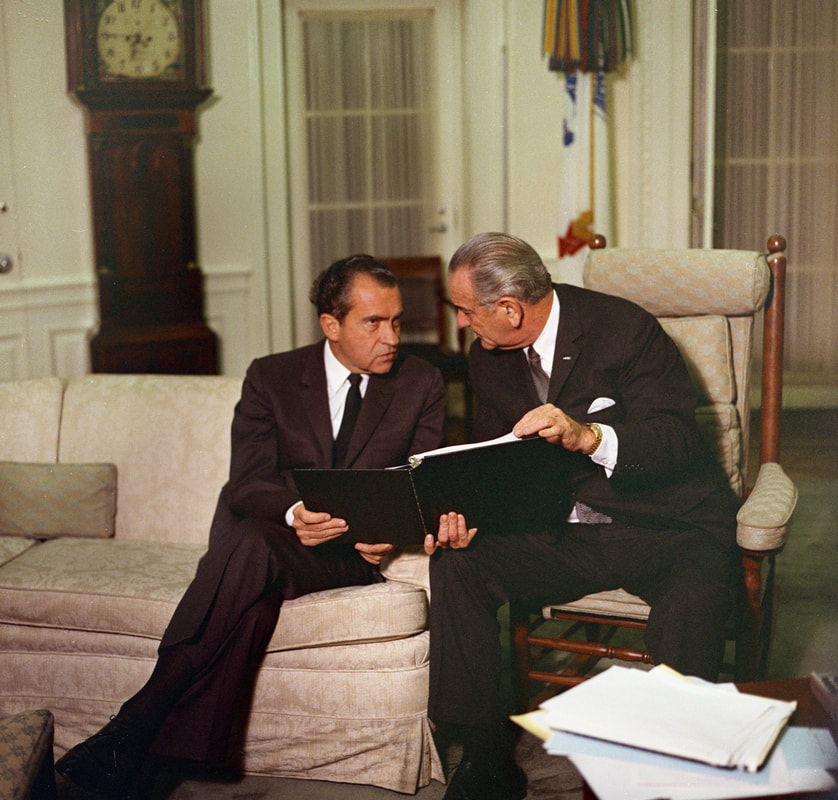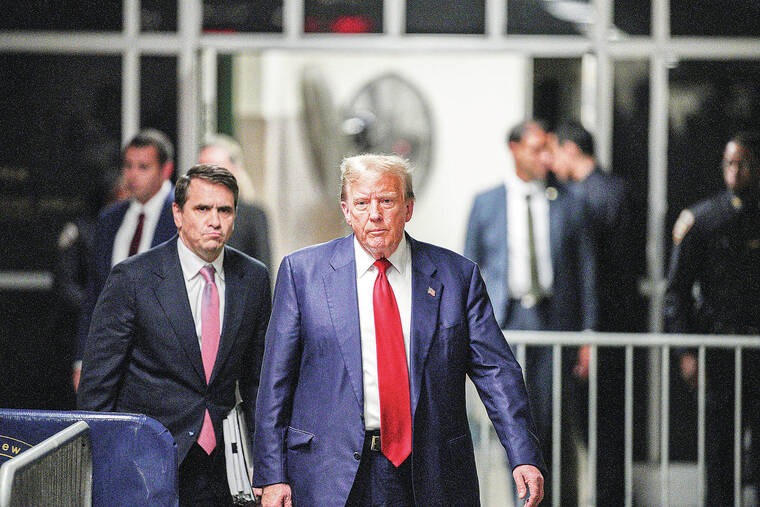After years of imploring the North Vietnamese to include South Vietnam in the negotiations with the U.S. to end fighting in Vietnam, a businessman alerted Johnson that Nixon feared that successful negotiations with North Vietnam would crush his chances of defeating his Democratic opponent, Hubert Humphrey. As a result, Nixon enlisted several Republican operatives to convince the South Vietnam government to refrain from participating in the negotiations until after the U.S. presidential elections. Johnson, seeking proof of Nixon's disloyalty, ordered the FBI to wiretap one of Nixon's operatives and the CIA to wiretap the office of South Vietnam's president. These wiretaps provided ironclad proof of Nixon's treachery. Because releasing the evidence would have raised questions about the propriety of wiretapping an ally, Johnson decided not to release the evidence. Nonetheless, President Johnson characterized Nixon's collaboration as treason because it quite likely needlessly cost the lives of U.S., South Vietnamese, and North Vietnamese troops as the Vietnam War ground on.
However, as the crisis continued over 444 days, confidence in Carter, already low, declined even further. The seizure of embassy personnel had a crippling effect on Carter's re-election bid that grew as the hostage crisis continued. This downward spiral was punctuated by a failed attempt by U.S. special forces to rescue the hostages. Nonetheless, Carter and his administration continued negotiations with the Iranians to release the embassy. The U.S. had some leverage in these negotiations because of increasing hostilities between Iran and Iraq. These hostilities would erupt into full-fledged war in September of 1980. Iran's military arsenal was based on U.S. systems, and Iran desperately needed weapons and replacement parts.
Bill Casey, Reagan’s long-time friend and campaign manager, was vociferous in his belief that if President Jimmy Carter could engineer the release of the hostages, he could still defeat Reagan. And if Casey believed this, it is unlikely that Reagan would have had a different opinion. Reagan's lead in the polls had been up and down, although Carter was trailing by the summer of 1980. Why would Reagan gamble on making a deal with the Ayatollah? Despite those concerns, Reagan had another consideration. This run for president was Reagan's third; he was 69 years old. He would almost certainly not have another opportunity to run for president again. Also, Reagan's victory would help seal right-wing supremacy in the Republican Party.
As the polls turned in Reagan's favor, Casey became more concerned about the possibility of some event derailing their expected victory. Casey became more apprehensive about an "October Surprise," an unexpected event redounding to Carter's advantage. In the summer of 1980, Casey devised a three-part plan for preventing an October Surprise. The first part consisted of establishing a committee of foreign-policy experts to monitor global events, especially those related to Iran, and alert the Reagan campaign to develop mitigation measures. The second part of the plan involved sending John Connolly, a former Texas governor, and his mentee, Ben Barnes, to Jordan, Syria, Lebanon, Saudi Arabia, Egypt, and Israel to relay a message to the Iranian government. Casey wanted these governments to let the Iranians know that they could expect a better deal for releasing the hostages from Reagan than from Carter. Connolly and Barnes, as directed, delivered Casey's message to the Middle East leaders. And the month after returning to Texas, they met with Casey for a debriefing. The third part of Casey's plan was for him to meet in Madrid with Ayatollah Mehdi Karrubi, a high-ranking representative of the Iranian government. Until recently, there was no evidence that Casey had met in Madrid with representatives of the Iranian government. This information was hidden and only discovered recently. Shielding Casey, Reagan's close friend, also shielded Reagan. But the discovery that this meeting occurred provides more evidence of Reagan’s guilt.
Casey and Connolly's message to the Iranians was that they would receive a better deal from Reagan than Carter. This message would have resonated with Khomeini because of his hatred for Carter (Carter had supported the Shah). Reagan also offered more to release the hostages than Carter. Whatever Reagan was promising would eventually be paid by the American people. Iran was fighting a deadly war against Iraq and needed U.S. arms and replacement parts for the U.S.-equipped military the Shah had built. Because of the embargo Carter had placed on the direct sales of military equipment to Iran, Israel became a middleman for the arms sales to the Iranians. However, Reagan promised to approve the sales, continuing the US position as primary source of weapons.
Any agreement between the Reagan campaign and Iran would involve commitments by the U.S. Any commitments made to Iran would be leverage the Iranians could use to pressure the U.S. to keep its deal. If Reagan had been engaged, those commitments to Iran would have been more likely fulfilled. Reagan, for example, publicly pledged to enforce the arms embargo against Iran. Even if Reagan had not been initially involved in dealing arms to Iran, it would have been nearly impossible to have fulfilled the agreement without letting him know. Reagan had promised that the U.S. would never ransom Americans held by terrorists. Yet, Reagan threatened to "call off the Iranian deal" unless the hostage, Cynthia Dwyer, the wife of Richard Allen, National Security Director's college roommate, was released by the Iranians, along with an Iranian American Rockwell International employee and three British missionaries. Ronald Reagan was directly involved in an arms-for-hostages negotiation despite his pledge not to engage in such swaps.
The circumstances of both the release of the embassy hostages and Cynthia Dwyer are strong circumstantial evidence that Reagan was involved in both arms-for-hostages deals. Reagan's inner circle members ensured his arms transfer participation was hidden. Within three months of Reagan's inauguration, his Secretary of State, Alexander Haig, gave implicit permission for Israel to ship U.S.-made military spare parts and fighter planes to Iran. The Israelis understood that the U.S. would replace the depletion of U.S. arms from Israel's stockpile to Iran.
Despite public pronouncements supporting a ban on arms sales to Iran and negotiations with terrorist groups like Hezbollah, the evidence seems clear that Reagan permitted additional arms to be sold to Iran through Israel. In 1984, when another group of hostages was seized by Hezbollah, including CIA Station Chief William Buckley, the Revs. Benjamin Weir, Lawrence Jenco, Peter Kilburn, David Jacobsen, Thomas Sutherland of American University, and Terry Anderson, an Associated Press correspondent, Reagan obtained the release of these hostages through arms sales to Iran. As bad as this later arms deal was, it was not as bad as the agreement Reagan made with the Ayatollah to stall the release of the embassy personnel. The discovery of the later arms deal seemed to be a distraction from any investigation or revelation about the delay in releasing the embassy personnel.
At the least, from the New Deal to Trump's MAGA Republicanism, the principles of conservatism have been changing. During the New Deal, conservatism was defined primarily as an anti-welfare ideology.
Ronald Reagan, father of the Republican party for the last 40 years, famously pleaded: "Mr. Gorbachev, tear down this wall." We can now see that the bricks Reagan wanted torn down were the underpinning of the Republican party. The shameful acts of these Republicans are not isolated. Seen in combination, they have built a new wall crushing the American people, the American dream, and the American Constitution. So, now we plead to the American people to tear down this wall.
Given what Nixon and Reagan committed to gain the presidency, it is not surprising that Trump committed crimes to gain the presidency. Unlike the Nixon and Reagan history, however, the State of New York judicial system indicted, tried and convicted Trump for falsifying his business records to interfere with the 2016 election. Trump followed the path set by Nixon and Reagan.
Nixon, Reagan, and Trump knew they were committing crimes and vigorously sought to conceal them. Because they were candidates for the office of president, they could not claim that their actions were necessary for the country. What they did compromised the US to acquire power for themselves. More importantly, the judicial system did not hold Nixon or Reagan accountable for the crimes they committed to gain power. Thus, the judicial system could not deter a later candidate. When Republicans ask what happened to their party, they need look no further than the ruthless pursuit of power in which preceding candidates engaged.




